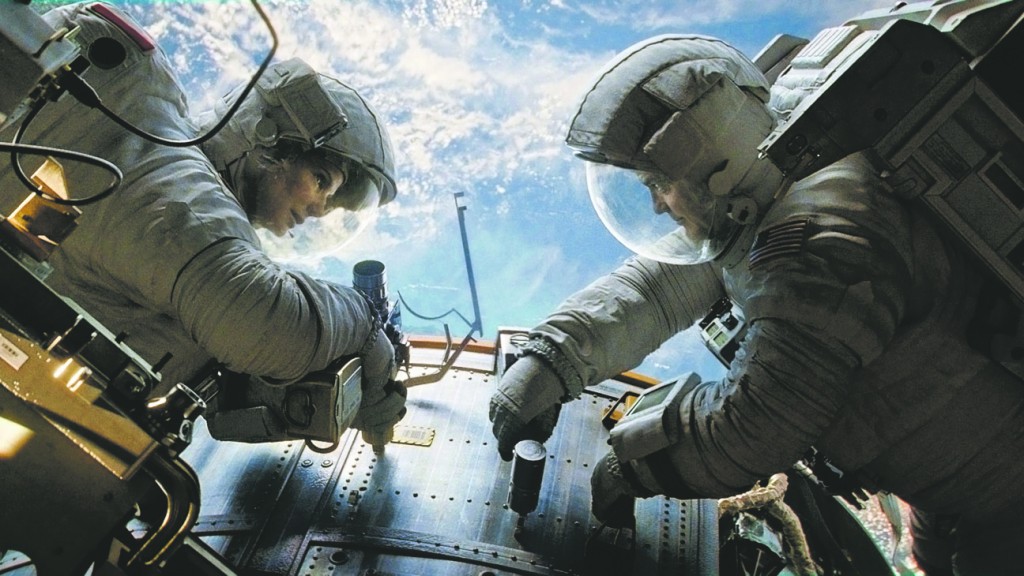
The elaborate shot that opens “Gravity” – a ballet that swoops up, down and around the Hubble Space Telescope and zooms in and out of the characters’ immediate spaces – is about 17 minutes long. Not that I checked the time – I couldn’t look away from the screen.
The Russian government sends a missile to its own satellite, blowing it up and sending debris hurtling at tens of thousands of miles per hour throughout space. It sets off a lethal chain reaction with other satellites and space debris. The debris strikes the Hubble telescope, killing NASA crew members and sending the androgynously named Dr. Ryan Stone (Sandra Bullock, in a role that will almost certainly nab her an Oscar nomination) plunging through space, with Matt Kowalski (George Clooney) not far behind.
The first thing people will tell you about “Gravity” is that it’s visually incredible and overwhelmingly thrilling. The movie is set in outer space and renders the people and objects within it with careful computer-generated detail that would make James Cameron blush (Cameron called “Gravity” “the best space film ever done”). The Earth, an orb in swashes of blue, white and green, remains in the background to remind us of how untethered we are, away from safe ground beneath our feet. The long shots are even more impressive than the ones in director Alfonso Cuarón’s previous movie, 2006’s “Children of Men.”
The second thing people will tell you is that, despite a visual majesty that rivals Stanley Kubrick’s “2001: A Space Odyssey,” the movie’s script doesn’t even come close to Kubrick’s smartness. It is little more than a survival story set in space. The dialogue, detractors say, is cliché, the backstory ham-fisted. The character-developing elements are a distraction from the fun space ride offered by director Cuarón, cinematographer Emmanuel Lubezki and visual effects supervisor Richard Baker (all wizards).
The movie, in fact, has a lot to say. Stone is a doctor working in the Hubble Telescope. She’s a single working former mother – her daughter tripped and died on a playground at the age of four. Sounds like the stuff of an unusually expensive Lifetime movie, but Cuarón uses the story of Stone’s daughter to provide an example of the universe’s restless indifference to human life and its ability to kill for the simplest of reasons. This is juxtaposed with the main narrative of the movie: Stone’s determination to survive in the most hostile conditions humankind has ever reached.
“Gravity” is obviously influenced by the visuals of “2001: A Space Odyssey” – it is perhaps the most technologically ambitious movie set in space since then – but Cuarón also responds to Kubrick’s ideas. In a 1968 interview with Playboy, around the time “2001” was released, Kubrick spoke about his relationship with the universe’s indifference.
“The most terrifying fact about the universe is not that it is hostile but that it is indifferent; but if we can come to terms with this indifference and accept the challenges of life within the boundaries of death – however mutable man may be able to make them – our existence as a species can have genuine meaning and fulfillment,” Kubrick said. “However vast the darkness, we must supply our own light.”
Stone and Kowalski refuse to accept the “boundaries of death.” “Life in space is impossible,” the movie’s prologue tells us, and the movie spends the next 90 minutes proving that wrong.
There is a shot in “Gravity” of Stone floating in fetal position with a space vehicle’s transparent circular hatch behind her. It echoes the final shot of “2001” of a baby, a superhuman, immersed in an orb of light, floating through space and looking at Earth. Both Cuarón and Kubrick are dealing with people facing extraordinary circumstances, but Cuarón has faith in humanity’s ability to face those circumstances. Kubrick, ever the pessimist, thinks that the indifference of our universe can only be faced by beings in the far future. Cuarón sets his movie in the present, among mankind’s greatest inventions, to show us the potential we already have, not only what could be.


